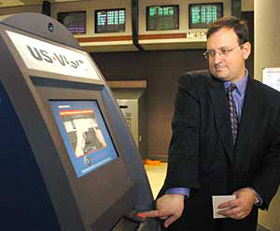 |
 |
 |
 News from Around the Americas | August 2005 News from Around the Americas | August 2005  
US Tests New Visa Checking System
 dawn.com dawn.com


| | Joe Newcomer demonstrates the new departure procedure for foreign visitors, using the US-VISIT biometric exit pilot. Visitors must record their fingerprints, have their pictures taken and have their passport digitally recorded at their departure gates. Previously, there was no real-time way of tracking foreign visitors when they left the country. (Photo: Gregory Smith) |
Washington - US immigration officials are testing a new visa program for foreign visitors that embeds tracking technology into the documentation that also can access private information, the Department of Homeland Security announced on Tuesday.

The proposed US-VISIT system uses radio frequency identification chips to track entrances and exits by visitors travelling under I-94 form visas and to flag criminals or terrorists. The long-term I-94 form visas often are used by students and business travellers.

The program will apply to students and businessmen coming to the US from countries like Pakistan but Canadian and Mexican nationals are exempted.

US VISIT is the continuation of security measures that collect biometric and biographic information from visitors at US visa-issuing posts around the world, and upon their arrival in and departure from US air, sea and land border ports.

“By testing this promising use of technology, we are taking another step to transform the way we gather information about entries and exits at our borders,” said Jim Williams, US-VISIT director.

“With the innovative use of technology, we can protect our citizens and visitors from threats to our security and allow valuable trade and travel into the US to continue and thrive,” Mr Williams said.

The technology was demonstrated on Monday at an entry port in New York and in Washington. The tests will run through next summer at five US land border ports and can be extended to all ports if successful.

“Ample justification exists to include Mexican visitors in US-VISIT. Mexico sends the largest number of visitors to the United States, and Mexicans make up the largest share of illegal aliens overall [70 per cent], and probably the largest share of overstays,” said Jessica Vaughan, author of the study.

Privacy advocates are sceptical of radio frequency identification, which businesses use to track inventory and the Pentagon uses to track military shipments. The tiny chips contain codes that can access a traveller’s private information stored in a separate database.

US-VISIT will collect and store on each traveller all 10 fingerprints plus their photo, name, date of birth, citizenship, sex, passport number, country of issuance, country of residence, visa number, date, place of issuance, alien registration number and address while staying in the United States. | 
 | |
 |



